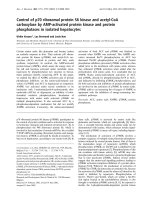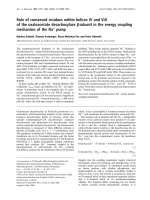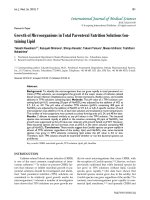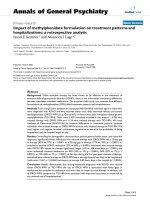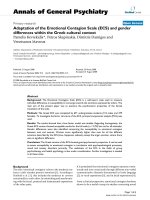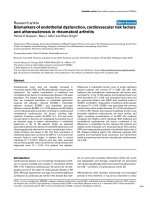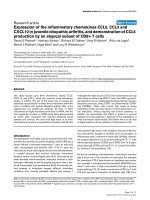Báo cáo y học: "Construction of Gene Regulatory Networks using biclustering and Bayesian networks" docx
Bạn đang xem bản rút gọn của tài liệu. Xem và tải ngay bản đầy đủ của tài liệu tại đây (1.55 MB, 50 trang )
This Provisional PDF corresponds to the article as it appeared upon acceptance. Fully formatted
PDF and full text (HTML) versions will be made available soon.
Construction of Gene Regulatory Networks using biclustering and Bayesian
networks
Theoretical Biology and Medical Modelling 2011, 8:39 doi:10.1186/1742-4682-8-39
Fadhl M Alakwaa ()
Nahed H Solouma ()
Yasser M Kadah ()
ISSN 1742-4682
Article type Research
Submission date 9 May 2011
Acceptance date 22 October 2011
Publication date 22 October 2011
Article URL />This peer-reviewed article was published immediately upon acceptance. It can be downloaded,
printed and distributed freely for any purposes (see copyright notice below).
Articles in TBioMed are listed in PubMed and archived at PubMed Central.
For information about publishing your research in TBioMed or any BioMed Central journal, go to
/>For information about other BioMed Central publications go to
/>Theoretical Biology and
Medical Modelling
© 2011 Alakwaa et al. ; licensee BioMed Central Ltd.
This is an open access article distributed under the terms of the Creative Commons Attribution License ( />which permits unrestricted use, distribution, and reproduction in any medium, provided the original work is properly cited.
- 1 -
Construction of Gene Regulatory Networks using
biclustering and Bayesian networks
Fadhl M Alakwaa
1*§
, Nahed H Solouma
2
and Yasser M Kadah
3*
1
University of Science and Technology, Sana'a, Yemen
2
Department of Biomedical photonics, Niles, Giza, (12613), Egypt
3
Department of Biomedical Engineering, Cairo University, Giza, (12613),
Egypt
*These authors contributed equally to this work
§
Corresponding author
Email addresses:
FMA:
NHS:
YMK:
- 2 -
Abstract
Background
Understanding gene interactions in complex living systems can be seen as
the ultimate goal of the systems biology revolution. Hence, to elucidate
disease ontology fully and to reduce the cost of drug development, gene
regulatory networks (GRNs) have to be constructed. During the last decade,
many GRN inference algorithms based on genome-wide data have been
developed to unravel the complexity of gene regulation. Time series
transcriptomic data measured by genome-wide DNA microarrays are
traditionally used for GRN modelling. One of the major problems with
microarrays is that a dataset consists of relatively few time points with respect
to the large number of genes. Dimensionality is one of the interesting
problems in GRN modelling.
Results
In this paper, we develop a biclustering function enrichment analysis toolbox
(BicAT-plus) to study the effect of biclustering in reducing data dimensions.
The network generated from our system was validated via available
interaction databases and was compared with previous methods. The results
revealed the performance of our proposed method.
Conclusions
Because of the sparse nature of GRNs, the results of biclustering techniques
differ significantly from those of previous methods.
- 3 -
Background
The major goal of systems biology is to reveal how genes and their products
interact to regulate cellular process. To achieve this goal it is necessary to
reconstruct gene regulatory networks (GRN), which help us to understand the
working mechanisms of the cell in patho-physiological conditions.
The structure of a GRN can be described as a wiring diagram that (1) shows
direct and indirect influences on the expression of a gene and (2) describes
which other genes can be regulated by the translated protein or transcribed
RNA product of such a gene [1].
The local topology of a GRN has been used to predict various systems-level
phenotypes. For instance, Dyer et al. [2] recently analyzed the intraspecies
network of Protein-Protein Interactions (PPIs) among the 1,233 unique human
proteins spanned by host-pathogen PPIs. They found that both viral and
bacterial pathogens tend to interact with hubs (proteins with many interacting
partners) and bottlenecks (proteins that are central to many paths in the
network) in the human PPI network.
Within the last few years, a number of sophisticated approaches to the
reverse engineering of cellular networks from gene expression data have
emerged. These include Boolean networks [3], Bayesian networks [4],
association networks [5], linear models [6], and differential equations [7].
The reconstruction of gene networks is in general complicated by the high
dimensionality of high-throughput data; i.e. a dataset consists of relatively few
time points with respect to a large number of genes. In this study we develop
- 4 -
a biclustering function enrichment analysis toolbox (BicAT-plus) to study the
effect of biclustering in reducing data dimension.
Clustering algorithms [8-10] have been used to reduce data dimension, on the
basis that genes showing similar expression patterns can be assumed to be
co-regulated or part of the same regulatory pathway. Unfortunately, this is not
always true. Two limitations obstruct the use of clustering algorithms with
microarray data. First, all conditions are given equal weights in the
computation of gene similarity; in fact, most conditions do not contribute
information but instead increase the amount of background noise. Second,
each gene is assigned to a single cluster, whereas in fact genes may
participate in several functions and should thus be included in several clusters
[11].
A new modified clustering approach to uncovering processes that are active
over some but not all samples has emerged, which is called biclustering. A
bicluster is defined as a subset of genes that exhibit compatible expression
patterns over a subset of conditions [12]. During the last ten years, many
biclustering algorithms have been proposed (see [13] for a survey), but the
important questions are: which algorithm is better? And do some algorithms
have advantages over others?
Generally, comparing different biclustering algorithms is not straightforward as
they differ in strategy, approach, time complexity, number of parameters and
predictive capacity. They are strongly influenced by user-selected parameter
- 5 -
values. For these reasons, the quality of biclustering results is also often
considered more important than the required computation time. Although
some comparative analytical studies have evaluated the traditional clustering
algorithms [14-16], no such extensive comparison exists for biclustering even
after initial trials have been made [12]. Ultimately, biological merit is the main
criterion for evaluation and comparison among the various biclustering
methods.
To the best of our knowledge, the biclustering algorithm comparison toolbox
has not been made available in the literature. We have developed a
comparative tool, BicAT-Plus (Figure 1), that includes comparative biological
methodology and is to be used as an extension to the BicAT program [17].
BicAT-Plus and its manual can be downloaded from these two links:
and
/>plus-manual.pdf
. BicAT is a java biclustering toolbox that contains five
biclustering and two traditional clustering algorithms.
In this work, one of our goals was to study the value of biclustering algorithms
for constructing GRNs.
Bonneau et al. [18] developed a GRN algorithm (The Inferelator) based on an
integrated biclustering method (cMonkey) [11]. cMonkey groups genes and
conditions into biclusters on the basis of three components: the expression
component, the sequence component, and the network component. Not all
the biclustering algorithms that are implemented either in BicAT or in our
- 6 -
modified version BicAT-Plus required prior information, so we excluded
cMonkey from further analysis.
Methods
Data Acquisition
Two well-known datasets of yeast microarray gene expression (Gasch et al.
[19]; Spellman et al. [20]) were used in this work; they can downloaded from
the Stanford Microarray Database ( The Spellman
dataset consists of four synchronization experiments (alpha factor arrest,
elutriation and arrest of CDC15 and CDC28 temperature-sensitive mutants),
which were performed for a total of 73 microarrays during the cell cycle. The
Gasch dataset contains 6152 genes and 173 diverse environmental transition
conditions such as temperature shock, amino acid starvation, and nitrogen
source depletion.
Preprocessing
Owing to daily Yeast chromosomal changes, the experiments of Gasch et al.
[19] and Spellman et al. [20] contain genes that no longer exist. We used the
SGD Batch Download web tool ( />bin/batchDownload) to remove all the merged, deleted and retired genes from
further processing.
Also, microarray measurements may be biased by diverse effects such as
efficiency of RNA extraction, reverse transcription, label incorporation,
exposure, scanning, spot detection, etc. This necessitates the preprocessing
- 7 -
of microarrays prior to data analysis. The datasets used in this work had
already been preprocessed for background correction and normalization.
Further steps should also be applied for data refinement. In this paper, we
applied commonly used preprocessing such as gene filtration and missing
value imputation[21-22].
Data Partitioning
BicAT is an open source tool written in Java swing and containing five
biclustering clustering algorithms (OPSM [23], ISA , CC [24], BIMAX [17] and
X-motive [25]) as well as two traditional ones (K-means and HCL [26]). The
proposed BicAT-Plus adds some features to BicAT. It is flexible and has a
well-structured design that can easily be extended to employ more
comparative methodologies, helping biologists to extract the best results from
each algorithm and interpret them in biologically useful biological ways. The
goal of BicAT-plus is to enable researchers and biologists to compare
different biclustering methods on the basis of a set of biological merits and to
draw conclusions about the biological meaning of the results. BicAT-Plus also
helps researchers to compare and evaluate the results of algorithms multiple
times according to user-selected parameter values as well as the required
biological perspective on various datasets. It adds many features to BicAT,
which can be summarized as follows:
• Two more biclustering methods are added: MSBE constant biclustering
and MSBE additive biclustering [27]. This enables the package to
employ most of the commonly used biclustering algorithms. MSBE is a
polynomial time algorithm for finding an optimal bi-cluster with
maximum similarity score. We added it because it has the following
- 8 -
advantages: (1) no discretization procedure is required, (2) it performs
well for overlapping bi-clusters and (3) it works well for additive bi-
clusters. When MSBE runs on real data (the Gasch dataset [19]), it
outperforms most existing methods in many cases.
• BicAT [17] is extended to perform functional analysis using the three
subontologies or categories of Gene Ontology (GO) (biological
process, molecular function and cellular component) and visualizing
the enriched GO terms for each bicluster in a separate histogram.
• A mean for the evaluation and result display is also added. This feature
helps in evaluating the quality of each biclustering algorithm result after
the GO functional analysis is applied. It then displays the percentages
of enriched biclusters at different significance levels.
• A method for comparing the different biclustering algorithms is also
provided. The comparison can be done according to the percentage of
the functionally enriched biclusters at the required significance levels,
the selected GO category and with certain filtration criteria for the GO
terms.
• A further important feature (to be added) is the ability to evaluate and
compare the results of external biclustering algorithms. This gives
BicAT-Plus the advantage of being a generic tool that does not depend
only on the methods employed. For example; it can be used to
evaluate the quality of new algorithms introduced to the field and
compare them against existing ones.
• The gene ontology enrichment results for each bicluster are visualized
using graphical and statistical charts in different modes (2D and 3D).
- 9 -
BicAT-Plus provides reasonable methods for comparing the results of
different biclustering algorithms by:
• Identifying the percentage of enriched or overrepresented biclusters
with one or more GO term per multiple significance level for each
algorithm. A bicluster is said to be significantly overrepresented
(enriched) with a functional category if the P-value of this functional
category is lower than the preset threshold. The results are displayed
using a histogram for all the algorithms compared at the different
preset significance levels, and the algorithm that gives the highest
proportion of enriched biclusters for all significance levels is considered
the optimum because it effectively groups the genes sharing similar
functions in the same bicluster.
• Identifying the percentage of annotated genes per each enriched
bicluster.
• Estimating the predictive power of algorithms to recover interesting
patterns. Genes whose transcription is responsive to a variety of
stresses have been implicated in a general Yeast response to stress
(awkward). Other gene expression responses appear to be specific to
particular environmental conditions. BicAT-Plus compares biclustering
methods on the basis of their capacity to recover known patterns in
experimental data sets. For example, Gasch et al. [19] measure
changes in transcript levels over time responding to a panel of
environmental changes, so it was expected to find biclusters enriched
with one of response to stress (GO:0006950), Gene Ontology
- 10 -
categories such as response to heat (GO:0009408), response to cold
(GO:0009409) and response to glucose starvation(GO:0042149).
Network Learning
Many reverse engineering approaches to establishing cellular networks from
gene expression data have emerged. Bayesian networks (BNs), which were
first used by Friedman et al. [4], have been widely used because of their solid
basis in statistics. BNs are also able to handle missing data and work with
incomplete knowledge about the biological system. There are two important
components to representing BNs: the qualitative part, which is called the
directed acyclic graph (DAG); and the quantitative part, which is the
conditional probability of children given their parents. The popular approach to
finding the best DAG is to search the DAG space and find the one with the
best score. Because the DAG space is huge, we have to use heuristic
searches. K2 algorithm, Greedy Search, Genetic Algorithm and Greedy Hill
Climbing are the popular search algorithms. The common objective of these
algorithms is to reduce the search space. More about the differences among
Bayesian network learning structure algorithms can be found in our previous
paper [28].
In this step, we first learn the biclusters produced from different algorithms
using the Greedy Hill Climbing search algorithm and BDe Scoring Function
implemented in Biolearn [29] at the Department of Biological Sciences,
Columbia University.
- 11 -
Network Generation
After we had obtained all the subnetworks generated from each biclustering
algorithm, these subnetworks were integrated by merging new edges and
deleting repeated edges to produce the final networks. For examples, for the
219 biclusters generated by the ISA algorithm, learning these biclusters would
produce 219 subnetworks. Merging them produced the whole network from
the ISA algorithm, which is consisted of 2558 edges.
Finally, we can summarize the procedures in the previous section for
generating the final networks as follows:
1. We applied the KNN imputation algorithm [21] to the Spellman dataset
in order to substitute the missing data point with the nearest values.
2. All data set genes showing no significant changes were removed.
3. We applied the spectral subtraction denoising algorithm to the dataset
[30].
4. Six biclustering algorithms (ISA [31], CC [24], MSBE [27], Bivisu [32],
OPSM [23], SAMBA) and one traditional clustering algorithm (k-means)
were applied to the Spellman dataset. The total number of
biclusters/clusters produced was 683.
5. We ran the Greedy Hill Climbing search algorithm implemented in the
Biolearn program [29] to these biclusters and produced 683
subnetworks.
6. These subnetworks were integrated to generate the whole gene
network for each biclustering algorithm. When we merged the edges
from all the biclustering/clustering algorithms, we produced a big
network containing 5440 unique edges. We refer to this network as the
ALL network.
- 12 -
Network Analysis and Validation
After the interactions among genes have been inferred, it remains assess whether
these relationships exist biologically. It is time and money consuming to validate the
full set of predictions experimentally. During the last decade, interaction databases
have grown exponentially. More than 230 web-accessible biological pathway and
network databases (www.pathguide.org) have been reported. These large databases
are very promising for assisting GRN inference and validating the inferred networks.
These interaction databases use different identifiers to identify the same gene (GI,
SwissProt, internal identifiers, etc.), which requires the resolution of synonymous
names/IDs across databases. So, we want to integrate molecular interactions and
other types of high-throughput data from different public databases to build biological
networks automatically. For this purpose we used BioNetBuilder [33] ,which is an
open-source client-server Cytoscape plug-in that offers a user-friendly interface to
create biological networks integrated from several databases. For example, the
BioNetBuilder client-server [33] retrieved more than 100,000 interactions for S.
cerevisiae from different databases as follows: (BIND, 16244); (BioGrid, 99485);
(DIP, 17465); (IntAct, 14331); (Interologger, 5395); (KEGG, 5478); (MINT, 11907);
the numbers here represent the number of interactions for each corresponding
database. Although the network retrieved by BioNetBuilder is still incomplete, we
consider it a gold standard network for comparison.
In addition, we have to compare our algorithm's performance via previous methods.
In this paper, we compare our algorithm with the Friedman algorithm. Friedman [4]
developed a new framework for discovering interactions between genes based on
multiple expression measurements that are capable of revealing causal relationships,
interactions between genes other than positive correlations, and finer intra-cluster
structure. He applied his approach to the dataset of Spellman et al. [20], containing
76 gene expression measurements of the mRNA levels of 6177 S. cerevisiae ORFs.
- 13 -
(Friedman’s network is available from (
nirf/GeneExpression/top800/).
Receiver operator characteristic (ROC) curve and precision recall (PR) curves are
commonly used for binary decision problems. We used the DREAM2 [34] evaluation
script to compute area and ROC and PR curves. We define some important terms as
follows:
• TP: Number of edges present in the gold network and in the predicted
network.
• FP: Number of edges not present in the gold network but included in the
predicted network.
• FN: Number of edges present in the gold network but not in the predicted
network.
• TN: Number of edges not present in the gold network and also not included in
the predicted network.
Definitions of TPR, FPR, Recall and Precision can be found in [35].
We also assess the credibility of the network generated by analyzing the network
topology using NetworkAnalyzer [36] and finding putative modules using MCODE
[37] and BINGO [38].
Results and Discussion
Biclustering
We applied BicAT-Plus to the S. cerevisiae gene expression data provided by
Gasch et al. [19]. The dataset contains 2993 genes and 173 diverse
- 14 -
environmental transition conditions such as temperature shock, amino acid
starvation, and nitrogen source depletion.
Table 1 shows the biclustering algorithm parameter settings as recommended
by the authors in their corresponding publications.
Table 2 demonstrates the statistical comparison of the bicluster outputs for
each algorithm. They differ in the number of bicluster outputs, the number of
genes and conditions within each bicluster, and the ability to recover genes
and conditions within its biclusters. CC produces large bicluster size (2259 x
134) because the objective function of this algorithm is to find large biclusters.
To that end, it includes an optimization algorithm that maximizes the number
of genes within the bicluster and at the same time minimizes the residual,
which is the difference between the actual value of an element x
ij
and its
expected value as predicted from the corresponding row mean, column mean,
and bicluster mean.
Comparison of these algorithms using the percentage of enriched biclusters is
shown in Figure 2 (histogram). By comparing Figure 2 with Figure 3 in [12,
27], we found that the percentages of enriched biclusters for the matched
algorithms are almost the same. This validates the results of the proposed
comparative tool. Investigating both figures, we observed that the OPSM
algorithm gave a high portion of functionally enriched biclusters at all
significance levels (from 85% to 100 %). Next to OPSM, ISA shows relatively
high portions of enriched biclusters.
- 15 -
In many simulations, we found that most of the enriched biclusters contain few
annotated genes. Figure 3 shows the percentage of enriched biclusters in
which at least half of their genes are annotated in any GO category. OPSM
and ISA have highly enriched biclusters with many annotated genes. In
contrast, the Bivisu and k-means biclusters are strongly affected by this
filtration as they contain fewer annotated genes in each category. Figure 3
helps to identify the most powerful and reliable algorithms for grouping the
maximum numbers of genes sharing the same functions in one bicluster.
Finally, given the ease of comparison allowed by BicAT-Plus, it was
straightforward to do further analysis to assess predictive power for
recovering interesting patterns; that is, to compare biclustering methods on
the basis of which of them recover known patterns in the particular
experimental dataset used. Table 3 shows the differences between the
bicluster contents based on their predictability to recover the response to
stress category. Although OPSM showed a high percentage of enriched
biclusters, it had no biclusters with genes matching any of the known GO
categories for the Gasch data set. Although there were few ISA biclusters (9)
and a low percentage of gene coverage (25%), it showed better performance
with one of its biclusters having 11 genes matching response to oxidative
stress (GO:0006979). We also see that three methods (k-means, CC and
ISA) were able to define biclusters with 4 out of 5 genes in the cellular
response to nitrogen starvation functional category, which is very striking.
Finally, we observe that several methods appear to be unique in detecting
- 16 -
biclusters related to certain function categories. For example, ISA and CC
detected two genes belonging to response to cold and cellular response to
starvation functions, respectively.
The comparison methodology used in this study indicates that the present
methods show no clear winner, and in fact it seems that all methods should
somehow be integrated together to capture the information in the data (i.e.
biclustering algorithms differ in strategy, approach, time complexity, number of
parameters and predictive capacity, so we expect that each algorithm can
recover what other algorithms cannot. So on inspection of Table 3, we
recommend biologists to run all biclustering algorithms on their data set and
select the enriched results.)
As Friedman used the Spellman [20] cell cycle dataset, we applied BicAT-
Plus to this dataset. We used the parameter settings shown in Table 4 and
produced the biclusters shown in Table 5. One remarkable observation is that
the gene coverage percentage of the ISA algorithm differs from the Spellman
dataset (91%) (see Table 5) and the Gasch dataset (25%) (see Table 2). This
confirms that each dataset has its unique signature, so integrating more than
one dataset enables biological knowledge to be extracted that could not be
extracted from a single dataset.
Network Validation
Figure 4 and Table 6 show the performance of the biclustering networks via
the gold network retrieved by BioNetBuilder [33] and the Friedman network
- 17 -
[4]. Inspecting Figure 4 and Table 7, we find that neither the networks
generated from different bicluster algorithms nor the ALL network perform
well. There are two important considerations when interpreting the results of
this comparison. First, the interactions documented are either physical or
genetic. This implies that they may not be direct interactions. The precision
may be lower than the actual precision since links may be missing in the
interactome databases; and the recall may be lower than the actual recall in
part because some of the links reported in the interactome databases may be
indirect [39]. Second, some presently unsupported edges in the constructed
network may find experimental evidence in the future. Therefore, these
unsupported edges are not necessarily false [40].
For the above reasons, the False Positive (FP) edges could be considered
True Positive (TP) if supporting evidence were found in the interaction
databases (gold network). For example, if the inference network includes an
edge between gene1 and gene3, which does not exist in the gold network,
and if these two genes were connected indirectly via another intermediate
gene such as gene2, we can now consider the edge between gene1 and
gene3 to be a true positive edge. To be entirely consistent we change TN
edge into a FN every time there is an interaction via an intermediate gene.
Table 8 and Figure 5 show the improvement in performance of the networks
after taking the above evaluation modification into consideration. Furthermore,
they show how most of the false positive edges in these networks have
evidence in the gold network (the seventh column in Table 8).
- 18 -
It should be mentioned that, as we expected, the sparse nature of the GNR
makes biclustering techniques (ISA, SAMBA, Bivisu) outperform the Friedman
network. This promotes the use of biclustering algorithms to overcome the
dimensionality problem in GRN inference.
As the success of biclustering algorithms in grouping functionally related
genes (i.e. producing highly enriched biclusters), the corresponding learned
subnetworks contain many true positive edges. This explains the performance
difference in Table 8. So the challenge to produce a real network is reflected
in finding enriched biclusters. Figures 2 and 3 and table 3 explain the high and
low performance of algorithms ISA and OPSM, respectively. As ISA produces
highly enriched biclusters (Figures 2 and 3) and is able to recover the
selected pattern (Table 3), it produced a more realistic network; the opposite
was the case for the OPSM algorithm. On the other hand, the ISA network
even outperforms the SAMBA network: SAMBA produces fewer biclusters
than ISA and recovers a lower percentage (see Table 5).
We also tried more than scoring functions. Figure 6 suggests that the ISA
network performs equally using NormalGamma and the BDe scoring function.
On the other hand, Figure 7 demonstrates that the ISA network using
GreedyHillClimbing outperformed the SparseCandidate algorithm with a
different size of candidate sets. Furthermore, decreasing or increasing the
size of the candidate sets beyond five affects the network performance
negatively.
- 19 -
To examine whether the performance on the datasets is typical of all network
reconstruction methods and is not particular to Bayesian networks with
biclustering, we ran another construction algorithm (linear regression) and
compared the resultant networks with those generated from the Bayesian
networks method. We used the LASSO algorithm, which is implemented in
Faisal et al. [41] at the Helsinki Institute for Information Technology
(
/>).
We used the cross-validation method to determine the best optimum lambda.
Figure 8 shows network performances using linear regression. Comparing
Figure 8 with the Bayesian results in Figure 5, we find the following:
• The performance of the CMSBE network does not change significantly.
• The performances of the ALL, OPSM and Bivisu, networks are greater
using the LASSO method than with the Bayesian networks method.
• The performances of the ISA, SAMBA and K-means, networks are
lower using the LASSO method than with the Bayesian networks
method.
We could conclude from Figures 5 and 8 that while different network
reconstruction algorithms will lead to differences in absolute performance,
different biclustering schemes consistently have similar relative performances,
irrespective of the network reconstruction algorithm used. Furthermore,
analyzing network topology increases the credibility of the predicted network.
We therefore analyzed the ISA network and the gold network using
NETWORKANALYZER [36]. Table 9 shows that these three important
- 20 -
parameters are the same in the two networks, indicating the high performance
of the ISA network.
Finally, one of the best methods for validating a network is to assess its
accumulated information using the information published in the biological
literature. Clustering algorithms have been used to identify molecular
complexes or modules in a large protein interaction network through network
connectivity [37]. A network module is a group of nodes in the network that
work together to execute some common function. We used the MCODE
Cytoscape plug-in [37] to detect densely connected regions in the ISA
network, which retrieved 39 modules. Figure 9 shows the highly scored
modules with the number of nodes and edges and the topology of each
module discovered. To validate the significance of the recovered modules,
their nodes are a portion of a complex, so there should be some process in
which they all operate. Thus, if we explore Gene Ontology (GO) term
enrichment using functional enrichment tools such as BINGO [38], we should
see some biological process with significant enrichment for these nodes [42].
Figure 10 demonstrates the functional enrichment of a highly scored module
using BINGO [38], which indicated that the module genes share three related
biological process: Chromatin assembly or disassembly, DNA Packaging and
Establishment and/or Maintenance of Chromatin Architecture.
Conclusions
The ongoing development of high-throughput technologies such as microarray
prompts researchers to study the complexity of gene regulatory networks
- 21 -
(GRNs) in cells. GRN inference algorithms have significant impact on drug
development and on understanding of disease ontology. Many GRN inference
algorithms based on genome-wide data have been developed to unravel the
complexity of gene regulation. Transcriptomic data measured by genome-
wide DNA microarrays are traditionally used for GRN modelling. This is
because RNA molecules are more easily accessible than proteins and
metabolites. One of the major problems with time series microarrays is that a
dataset consists of relatively few time points with respect to a large number of
genes. Reducing the data dimensions is one of the interesting problems in
GRN modelling. The most common and important design rule for modelling
gene networks is that their topology should be sparse. This means that each
gene is regulated by only a few other genes. In this work, a new gene
regulatory network (GRN) construction system from a large microarray
dataset and prior biological information was proposed. As we expected,
because GRNs are sparse, biclustering techniques show significant results
compared to the Friedman network [4]. In this paper, we show the impact of
using biclustering algorithms in GRN construction. Sophisticated filtration
procedures such as data filtration, missing value imputation, normalization
and discretization were used to reduce the number of expression profiles to
some subset that contains the most significant genes.
Also, the biclustering comparison toolbox (BicAT-Plus) implemented in this
paper confirms that the bicluster and cluster algorithms can be considered as
an integrated module; there is no single algorithm that can recover all the
interesting patterns. What algorithm A recovers in certain data sets, Algorithm
- 22 -
B might fail to recover, and vice versa. We can identify the highly enriched
biclusters in all the algorithms compared, integrating them to solve the
dimensionality problem of GRN construction.
Moreover, the study in this paper confirms the ability of Bayesian Networks
(BNs) structure algorithms to recover gene network structures accurately. BNs
allow us to deal with the noise inherent in experimental measurements and to
model the hidden variables in the data.
Surprisingly, the networks generated in this study show sufficient accuracy
when compared to previous work and existing biological databases such as
BIOGRIDE. Also, validation of the generated network using popular validation
algorithms such as MCODE and NetworkAnalyzer adds more credibility to our
algorithm. The data used in the validation step is not used for modelling. On
the other hand, putative modules were recovered from our method, which
suggests the need for more analysis to recover and test unknown complex
modules.
We implemented the algorithm in Java. The program is open source and can
be obtained from the authors.
Competing interests
The authors declare that they have no competing interests.
- 23 -
Authors' contributions
The initial idea of the algorithm was developed by all the authors. FA
developed and tested the software. All the authors wrote and approved the
manuscript.
Acknowledgements
This work is supported by a grant from the University of Science &
Technology, Yemen. The authors would like to thank Prof Dana Pe'er,
Columbia University; Dr Kevien Yip, Yale University and Prof G. Stolovitzky,
IBM Computational Biology Center for helpful discussions. We also thank
Stanford Microarray Database for making microarray data available
and the lab members for the courteous help they gave us.
References
1. Ronald C. T, Mudita S, Jennifer W, Saeed K, Liang S, Jason M: A Network
Inference Workflow Applied to Virulence-Related Processes in
Salmonella typhimurium. Ann N Y Acad Sci 2009, 1158:143-158.
2. Dyer MD, Murali TM, Sobral BW: The Landscape of Human Proteins
Interacting with Viruses and Other Pathogens. PLoS Pathog 2008, 4:e32.
3. Kauffman S: Homeostasis and Differentiation in Random Genetic Control
Networks. Nature 1969, 224(5215):177-178.
4. Friedman N, Linial M, Nachman I, Pe'er D: Using Bayesian networks to
analyze expression data. In: Proceedings of the fourth annual international
conference on Computational molecular biology; Tokyo, Japan. 332355:
ACM 2000: 127-135.
5. Wolfe C, Kohane I, Butte A: Systematic survey reveals general
applicability of ``guilt-by-association'' within gene coexpression networks.
BMC Bioinformatics 2005, 6(1):227.
6. D haeseleer P, Wen X, Fuhrman S, Somogyi R: Linear modeling of mRNA
expression levels during CNS development and injury. In: 4th Pacific
Symposium on Biocomputing. Big Island of Hawaii; 1999.
- 24 -
7. Chen T, Hongyu LH, Church GM: Modeling gene expression with
differential equations. In: 4th Pacific Symposium on Biocomputing. Big
Island of Hawaii; 1999.
8. Tavazoie S, Hughes J, Campbell M, Cho R, Church G: Systematic
determination of genetic network architecture. Nature Genetics 1999,
22:281-285.
9. Guthke R, Moller U, Hoffmann M, Thies F, Topfer S: Dynamic network
reconstruction from gene expression data applied to immune response
during bacterial infection. Bioinformatics 2005, 21(8):1626-1634.
10. D’haeseleer P, Liang S, Somogyi R: Genetic network inference: from co-
expression clustering to reverse engineering. Bioinformatics 2000,
16(8):707-726.
11. Reiss D, Baliga N, Bonneau R: Integrated biclustering of heterogeneous
genome-wide datasets for the inference of global regulatory networks.
BMC Bioinformatics 2006, 7(1):280.
12. Prelic A, Bleuler S, Zimmermann P, Wille A, Buhlmann P, Gruissem W,
Hennig L, Thiele L, Zitzler E: A Systematic comparison and evaluation of
biclustering methods for gene expression data. Bioinformatics 2006,
22(9):1122 - 1129.
13. Madeira SC, Oliveira AL: Biclustering algorithms for biological data
analysis: a survey. IEEE/ACM Trans Comput Biol Bioinform 2004, 1(1):24 -
45.
14. Yeung KY, Haynor DR, Ruzzo WL: Validating clustering for gene
expression data. Bioinformatics, 17(4):309-318.
15. Datta S, Datta S: Comparisons and validation of statistical clustering
techniques for microarray gene expression data. Bioinformatics 2003,
19(4):459-466.
16. Azuaje F: A cluster validity framework for genome expression data.
Bioinformatics 2002, 18(2):319-320.
17. Barkow S, Bleuler S, Prelic A, Zimmermann P, Zitzler E: BicAT: a
biclustering analysis toolbox. Bioinformatics 2006, 22(10):1282-1283.
18. Bonneau R, Reiss D, Shannon P, Facciotti M, Hood L, Baliga N, Thorsson V:
The Inferelator: an algorithm for learning parsimonious regulatory
networks from systems-biology data sets de novo. Genome Biology 2006,
7(5):R36.
19. Gasch AP, Spellman PT, Kao CM, Carmel-Harel O, Eisen MB, Storz G,
Botstein D, Brown PO: Genomic Expression Programs in the Response of
Yeast Cells to Environmental Changes. Mol Biol Cell 2000, 11(12):4241-
4257.
20. Spellman PT SG, Zhang MQ, Iyer VR, Anders K, Eisen MB, Brown PO,
Botstein D, Futcher B.: Comprehensive identification of cell cycle-
regulated genes of the yeast Saccharomyces cerevisiae by microarray
hybridization. Mol Biol Cell 1998, 9(12):3273-3297.
21. Troyanskaya O, Cantor M, Sherlock G, Brown P, Hastie T, Tibshirani R,
Botstein D, Altman RB: Missing value estimation methods for DNA
microarrays. Bioinformatics 2001, 17(6):520-525.
22. Isaac SK, Alvin K, Atul JB: Microarrays for an Integrative Genomics: The
MIT Press; 2003.
